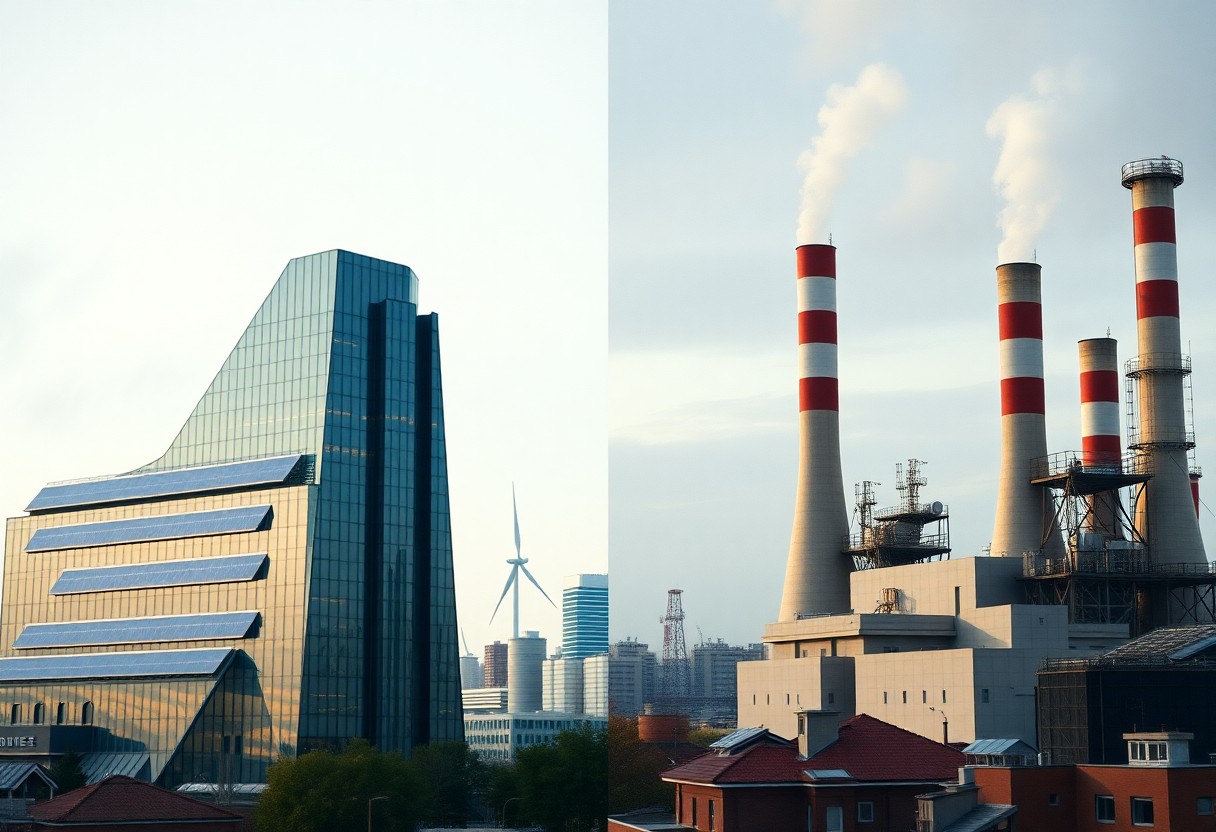Over time, you may have wondered whether all energy companies function with the same level of efficiency, or if a hidden divide exists that impacts your energy costs and sustainability. In this blog post, we will explore the varying degrees of performance among energy providers, examining factors like operational practices, technology adoption, and customer service that can significantly influence not only your energy bills but also the environment. By understanding these differences, you can make more informed choices about your energy provider.
The Metrics of Efficiency in Energy Companies
To discern the efficiency of energy companies, various metrics play a significant role. These metrics typically encompass operational performance, financial health, and customer satisfaction, each providing insights into how effectively a company utilises its resources. By analysing these indicators, you can gauge whether a company is merely performing well or is genuinely operating at an optimal level.
Assessing Operational Efficiency
Against this backdrop, operational efficiency becomes a benchmark for evaluating energy companies. You might consider factors such as energy production costs, maintenance expenses, and the effectiveness of technology deployment. These components are indicative of a company’s ability to deliver energy reliably while minimising waste.
Financial Performance as an Indicator
On the other hand, financial performance often emerges as a prominent indicator of energy efficiency. You should assess revenue generation, profit margins, and return on investment, as these factors reflect how well a company translates operational efficiency into monetary results.
Another aspect you should consider is that while high profits can generally indicate a well-performing energy company, a significant disparity in financial performance may also highlight underlying inefficiencies. Unsustainable profit margins or a lack of reinvestment in infrastructure can signify that a company is not functioning at its full potential. Consequently, it is important to analyse both current financial metrics and long-term sustainability plans to fully understand a company’s efficiency. Your insights here can guide you towards identifying energy companies that prioritise both immediate performance and future stability.
Factors Influencing Efficiency
Some key variables determine the efficiency of energy companies, including technology, regulatory compliance, operational practices, and market conditions. These elements interact to create noticeable differences in performance among providers. The effectiveness of a company’s infrastructure and its ability to adapt to changing environments can significantly influence its overall efficiency. Assume that more efficient companies can offer competitive pricing and better services than their less efficient counterparts.
Technology and Innovation
For energy companies, embracing technology and innovation is crucial to improve efficiency. Advanced technologies, such as smart grids and renewable energy sources, can enhance operational performance and reduce waste, leading to better service delivery for you as a consumer.
Regulatory Environment
Environment regulations play a significant role in shaping the efficiency of energy companies. Compliance with stringent regulations often necessitates investments in cleaner technologies, which may enhance efficiency but also increase operational costs. Poorly designed regulations can stifle innovation and render companies less competitive.
Another major aspect of the regulatory environment is that it can create a mixed bag of implications for energy companies. While regulations can promote safety standards and environmental protection, they can also lead to increased bureaucracy and costs if not well-structured. Therefore, you may find that an energy company’s efficiency hinges on its capability to navigate these rules effectively while still innovating and delivering cost-effective solutions.
The Role of Renewable Energy
If you consider the increasing demand for energy and the urgent need to combat climate change, renewable energy emerges as a pivotal factor in shaping the future of energy efficiency. While traditional sources contribute to greenhouse gas emissions, harnessing solar, wind, and hydropower enables your energy provider to lower its carbon footprint and improve supply reliability. However, not all companies invest equally in these sustainable sources, revealing a hidden divide that could impact your choices and the environment.
Transitioning to Sustainable Practices
One of the most significant shifts in the energy sector is the move towards sustainable practices. As you become more conscious of environmental impacts, energy companies are compelled to adopt green technologies and practices to remain competitive. This transition not only requires a change in infrastructure but also an investment in innovation, ensuring that your energy consumption aligns with a more sustainable future.
Impact on Overall Efficiency
Before discussing energy efficiency, consider how the integration of renewable energy affects your overall consumption. By utilising sustainable sources, energy companies can enhance their operational performance, leading to improved efficiency across the board.
A deeper examination reveals that integrating renewable sources into the energy mix can significantly boost overall efficiency. When energy suppliers harness wind, solar, and hydroelectric power, they often achieve lower operational costs and reduced reliance on fossil fuels, which are subject to price volatility. Consequently, your energy bills can potentially decrease as companies pass on savings. Additionally, as renewable energy expands, it fosters greater resilience against market disruptions and enhances energy security, benefitting both you and the environment in the long run.
Case Studies of Efficient vs. Inefficient Companies
Many energy companies demonstrate significant disparities in their operational efficiency. Here are several case studies illustrating this hidden divide:
- Company A: Achieved a 20% reduction in operational costs through advanced technology.
- Company B: Reported a 15% increase in customer satisfaction ratings due to sustainability initiatives.
- Company C: Struggled with 25% higher emissions than industry average, resulting in regulatory fines.
- Company D: Documented a 30% decline in energy losses after implementing smart grid technologies.
Successful Models
Efficient companies typically exhibit remarkable operational structures, utilising cutting-edge technologies and innovative practices that lead to enhanced productivity and customer satisfaction. For instance, Company A’s integration of artificial intelligence significantly streamlined its resource management, illustrating how adopting modern solutions can yield substantial benefits.
Lessons from Underperformers
Against this backdrop, the failures of underperforming companies highlight vital lessons for you. These companies often suffer from outdated infrastructures, lack of investment in renewable sources, and insufficient customer engagement strategies. By examining their shortcomings, you can better understand the pitfalls to avoid in your own energy practices.
Inefficient models often illustrate a dangerous cycle of declining performance. For example, Company C not only faced financial losses due to exorbitant emissions fines but also struggled with negative public perception, which hampered its ability to attract new customers. These cases serve as a stark reminder of the importance of adopting sustainable practices and investing in technological advancements to avoid similar fates in your own operations.
The Hidden Divide: Market Variations
Unlike what some may assume, not all energy companies operate with the same level of efficiency. Market variations significantly influence how effectively these companies deliver services and innovate, creating a hidden divide that can impact your energy costs and reliability. Understanding these differences is necessary to make informed choices about your energy provider.
Regional Discrepancies
Along with market variations, regional discrepancies play a critical role in the efficiency of energy companies. Depending on your location, the availability of resources, infrastructure, and regulatory environments can differ greatly. This uneven landscape means some areas may benefit from more competitive pricing and better service, while others may endure higher costs and limited options.
Competitive Landscape
The competitive landscape of the energy market can also lead to variations in efficiency among companies. Companies that face robust competition are often incentivised to offer lower prices and improve service quality. In contrast, those in less competitive regions may lack the drive for efficiency, ultimately affecting your overall experience and costs.
Discrepancies in the competitive landscape can create a significant divide in energy efficiency. In areas with strong competition, you are more likely to find energy providers that invest in renewable sources and innovative technologies, leading to improved service reliability and potentially lower bills. Conversely, in markets where few suppliers dominate, you might find yourself facing higher prices and outdated practices, diminishing your overall energy experience. This reality underscores the necessity of researching your local energy market, as the difference can greatly affect both your pocket and the environment.
Future Trends in Energy Efficiency
Despite the ongoing evolution in the energy sector, disparities in efficiency persist among companies. You may observe a growing emphasis on adopting advanced practices and technologies aimed at optimising energy production and consumption. As companies strive for sustainability, the pressure to invest in energy-efficient systems is only set to increase, leading to a significant divide between industry leaders and laggards.
Emerging Technologies
Around the world, innovative technologies are reshaping the energy landscape. You can expect to see advancements in artificial intelligence, smart grids, and energy storage solutions that enhance energy efficiency. These technologies not only enable real-time energy management but also facilitate greater transparency in energy consumption, offering you more control over your energy use.
Anticipated Regulatory Changes
On the horizon, regulatory changes are expected to significantly impact energy efficiency initiatives. You will likely encounter stricter guidelines aimed at curbing energy waste and promoting sustainable practices across the board.
For instance, new regulations could mandate minimum energy performance standards for appliances and industrial machinery, compelling manufacturers to develop more efficient products. Additionally, the potential for increased financial incentives for both consumers and businesses embracing energy-efficient solutions is on the table. Such changes aim to reduce carbon emissions while encouraging the adoption of renewable energy sources, thus driving a market where efficiency becomes not just a preference but a necessity for compliance and competitiveness.
Final Words
Now that you’ve explored the complexities of energy company efficiency, it’s clear that not all companies operate on the same level. There can be significant disparities in performance, innovation, and customer satisfaction across the sector. As you navigate your options, consider not just pricing, but also the efficiency and sustainability practices of your chosen provider. This informed approach can lead to better choices for both your wallet and the environment, ensuring you align with a company that meets your energy needs effectively.
FAQ
Q: Are all energy companies equally efficient in their operations and services?
A: Not all energy companies operate with the same level of efficiency. Several factors contribute to the differences in efficiency, including infrastructure, technology, management practices, and investment in renewable energy sources. Some companies may prioritise sustainable practices and innovative solutions, leading to better energy efficiency and reduced environmental impact, while others may focus primarily on cost reduction, which can affect their overall performance and sustainability.
Q: What are the indicators of efficiency among energy companies?
A: Key indicators of efficiency among energy companies include energy loss rates during transmission and distribution, utilisation of renewable energy sources, customer satisfaction ratings, and overall operational costs. Additionally, companies that invest heavily in smart grid technologies and energy management systems are likely to demonstrate higher efficiency levels. By analyzing these indicators, consumers can make more informed choices about the energy providers they choose.
Q: Is there a way to compare the efficiency of different energy companies?
A: Yes, there are various resources available for comparing the efficiency of different energy companies. Regulatory agencies and independent organisations often publish performance reports and rankings based on efficiency metrics. Customers can also utilise comparison websites that evaluate energy suppliers based on factors like cost, customer service, and sustainability initiatives. Engaging with these resources can provide insights into the hidden divides in efficiency among energy companies.




0 Comments